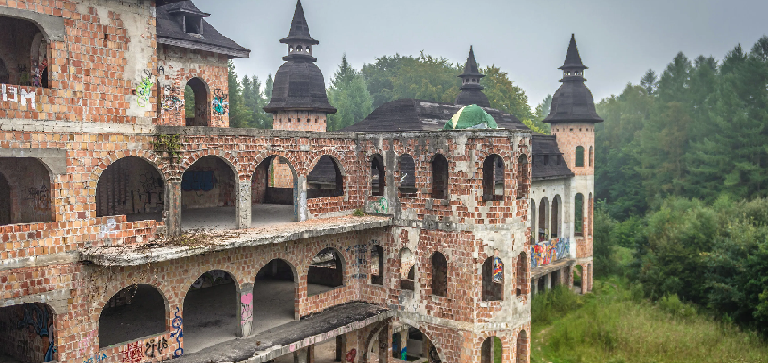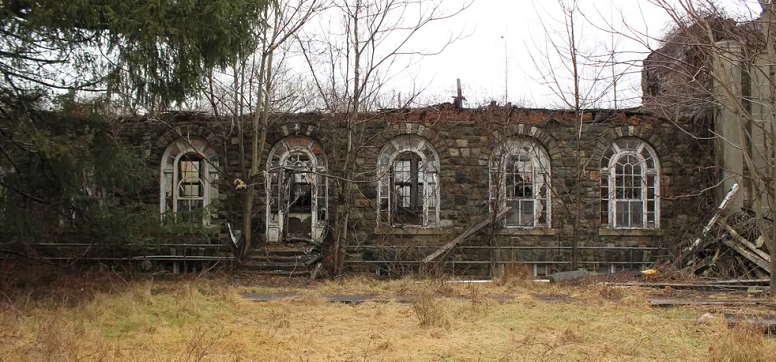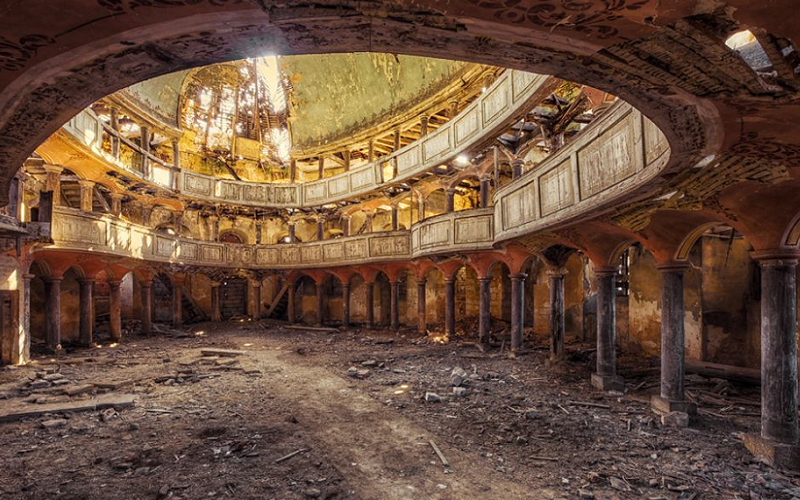Abandoned or ruined buildings are often viewed as eyesores in our communities, but they hold a rich cultural significance that is often overlooked. These structures serve as tangible reminders of our past, providing insight into the lives and beliefs of previous generations. The restoration of these buildings not only revitalizes our communities, but it also helps preserve our cultural heritage for future generations.
Definition of Abandoned or Ruined Buildings
Abandoned or ruined buildings are structures that have been deserted, neglected, or left to deteriorate over time. These buildings can range from residential homes, commercial properties, religious institutions, to industrial structures. Abandonment can occur for a variety of reasons, including economic hardship, natural disasters, technological advancements, or changes in land use.
Ruined buildings, on the other hand, are structures that have been damaged or partially destroyed, either through natural causes such as earthquakes or fires, or through human actions such as wars or vandalism. These structures may still possess significant architectural, historical, or cultural value, despite their current state of disrepair.
Regardless of the cause of abandonment or ruination, these structures often evoke a sense of nostalgia and evoke memories of a bygone era. They serve as a reminder of the past and the cultural, economic, and social changes that have shaped our communities. As such, abandoned or ruined buildings hold significant cultural significance, and their preservation and restoration can play an important role in preserving our cultural heritage for future generations.
Historical Significance of Abandoned or Ruined Buildings
Abandoned or ruined buildings hold immense historical significance as they serve as tangible reminders of our past and provide insight into the lives and beliefs of previous generations. These structures can serve as a window into the cultural, economic, and social conditions that existed in a particular time and place.
For example, abandoned factories can tell the story of industrialization and the rise of the working class, while ruined castles and fortresses can shed light on feudal societies and the struggle for power and control. Religious institutions such as churches and temples can also provide insight into the religious beliefs and practices of previous generations.
The preservation and restoration of abandoned or ruined buildings can also play an important role in preserving our cultural heritage. By restoring these structures to their former glory, we not only revitalize our communities, but we also preserve an important part of our shared history. The restoration of these buildings can also serve as a source of pride for local communities, and can serve as a testament to the resilience of the human spirit in the face of adversity.

Cultural Significance of Restoration of Abandoned or Ruined Buildings
The restoration of abandoned or ruined buildings holds significant cultural significance as it not only revitalizes our communities but also enhances the cultural identity and heritage of a place. Restoration can have far-reaching benefits, both tangible and intangible, for the local community and beyond.
The restoration of abandoned or ruined buildings can play a key role in revitalizing communities by bringing new life to neglected or derelict areas. The restoration process can create jobs, stimulate economic growth, and encourage investment in the local area. The revitalization of these structures can also help to improve the quality of life for local residents by providing new public spaces and cultural attractions.
The restoration of abandoned or ruined buildings can also enhance the cultural identity and heritage of a place by preserving important historical landmarks and cultural landmarks. These structures can serve as tourist attractions, drawing visitors from around the world and generating revenue for the local economy. By restoring these buildings to their former glory, we not only celebrate our cultural heritage but also help to ensure that it is passed down to future generations.
The restoration of abandoned or ruined buildings can also have a positive impact on the environment. The preservation and restoration of these structures can help to reduce waste, conserve resources, and promote sustainability. By preserving these structures and incorporating sustainable design principles, we can help to create a more livable and sustainable future for our communities.

The Restoration Process of Abandoned or Ruined Buildings
The restoration process of abandoned or ruined buildings is a complex and multi-faceted endeavor that requires careful planning, expert knowledge, and a deep appreciation for the cultural significance of these structures. The restoration process typically involves several key steps, including assessment, planning, and implementation.
Assessment of the Building
The first step in the restoration process is to assess the historical significance, cultural value, and physical condition of the building. This step involves conducting a thorough survey of the structure to determine the extent of the damage, the materials used in its construction, and any unique features that should be preserved. This information is then used to develop a restoration plan that takes into account the cultural significance of the building and its importance to the local community.
Developing a Restoration Plan
Once the assessment is complete, the next step is to develop a detailed restoration plan. This plan should take into account the historical significance, cultural value, and physical condition of the building, as well as the resources and funding available for the restoration project. The restoration plan should also consider the views and opinions of local residents and stakeholders, as well as any environmental or sustainability considerations.
Implementation of the Restoration Plan
Once the restoration plan has been developed, the next step is to implement the restoration work. This may involve repairing or replacing damaged or missing components, cleaning and stabilizing the building, and restoring any unique or cultural features. The restoration work should be carried out by skilled professionals who have experience in the preservation and restoration of historic buildings.
Monitoring and Maintenance of the Restored Building
The final step in the restoration process is to monitor and maintain the restored building. This may involve regular inspections and maintenance work to ensure that the building remains in good condition, and to address any issues that may arise over time.
Examples of Successful Restorations of Abandoned or Ruined Buildings
There are many examples of successful restorations of abandoned or ruined buildings from around the world that showcase the cultural significance and potential of these structures. Here are a few notable examples:
Europe: Gothic Cathedrals, Roman Ruins
In Europe, there are many examples of successful restorations of abandoned or ruined buildings, including Gothic cathedrals and Roman ruins. For example, Notre-Dame Cathedral in Paris, France, was extensively damaged in a fire in 2019, but has since undergone a successful restoration that has returned the cathedral to its former glory. Similarly, the Colosseum in Rome, Italy, is one of the best-preserved ancient Roman structures and is now a major tourist attraction.
North America: Abandoned Factories, Theaters
In North America, there are many examples of abandoned or ruined buildings that have been successfully restored, including abandoned factories and theaters. For example, the Powerhouse Building in Buffalo, New York, was once a thriving power plant, but was abandoned for many years before being restored and converted into a cultural center. Another example is the Fox Theatre in Detroit, Michigan, which was abandoned for many years before being restored and transformed into a thriving cultural venue.
Asia: Buddhist Temples, Castles
In Asia, there are many examples of abandoned or ruined buildings that have been successfully restored, including Buddhist temples and castles. For example, the Todai-ji Temple in Nara, Japan, was once one of the largest wooden buildings in the world, but was severely damaged by fire and earthquakes over the centuries. Today, the temple has been restored to its former glory and is a major tourist attraction. Another example is the Himeji Castle in Himeji, Japan, which was abandoned and in disrepair for many years before being restored and transformed into a museum.

The Future of Abandoned or Ruined Buildings
The future of abandoned or ruined buildings is uncertain, but it is clear that these structures will continue to play an important role in shaping our communities and preserving our cultural heritage. The preservation and restoration of abandoned or ruined buildings can have far-reaching benefits for local communities and beyond, and it is essential that we continue to invest in these projects in the years to come.
The Importance of Preservation of Ruined Buildings
The preservation of abandoned or ruined buildings is more important now than ever before. These structures are a testament to our cultural heritage and provide insight into the lives and beliefs of previous generations. By preserving these buildings, we not only celebrate our cultural heritage but also help to ensure that it is passed down to future generations.
Increasing Awareness of the Significance of Ruined Buildings
To ensure the future of abandoned or ruined buildings, it is essential that we increase awareness of their cultural significance. This can be achieved through education and outreach programs, as well as through the promotion of restoration projects. By increasing public awareness of the cultural significance of these structures, we can help to secure their future and ensure that they continue to play an important role in shaping our communities.
The Role of Governments and Private Organizations In Preservation
Governments and private organizations play a critical role in the preservation and restoration of abandoned or ruined buildings. Governments can provide funding and support for restoration projects, while private organizations can provide expertise and resources. By working together, these groups can help to ensure that these structures are preserved and restored for future generations.

